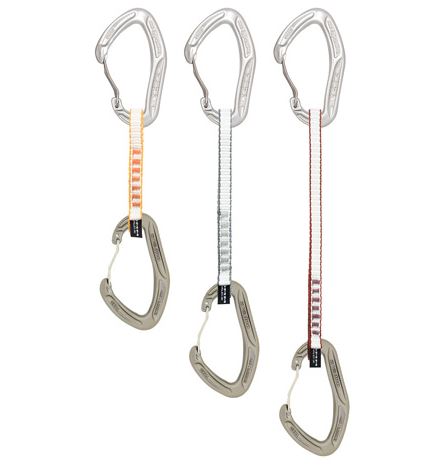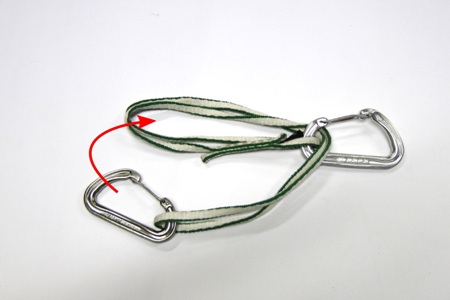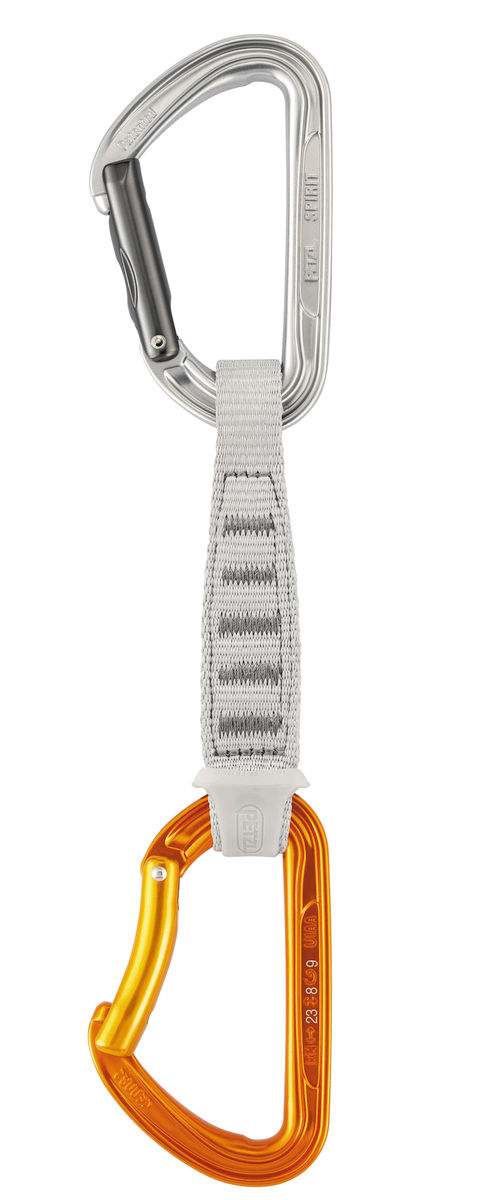Proper Way to Use Quick Draws
Climbers use quickdraws to attach their rope to pieces of protection when lead climbing. A quickdraw consists of two karabiners connected by a textile sling. Find out about the different types and some of the key issues in this article.
Quickdraws, which are also sometimes called extenders, are a useful item of equipment for climbing and mountaineering. Their primary function is to connect the rope to protection, but other requirements which vary according to the type of climbing have led to the evolution of several distinct variations on the basic theme.
Climbs often follow a devious line. The skillful climber uses quickdraws to help keep the path of any ropes straight, avoiding sharp changes in rope direction. Doing so reduces friction, which means less rope drag and enables more fluid climbing movement.
Quickdraws for trad climbing

For trad climbing where protection is leader placed, a smooth running rope also prevents protection from being pulled upwards and out of good placements. Less well known is that a free running rope leads to lower forces on the top protection piece. For trad climbing then, a variety of different quickdraw lengths are useful, although the majority should be around 20cm or so in length.
For longer pitches on adventurous terrain, a large number of quickdraws may be needed, hence the modern trend has been to reduce weight by using wiregate karabiners and thin Dyneema slings. A rubber keeper which holds the bottom karabiner in position has several advantages - clipping the rope is easier, and the karabiner can't spin and become cross loaded by accident.
Slingdraws

For trad climbing, and even more so in winter and in alpinism, a few longer slings become useful to keep the rope path straight and smooth running despite a route which may weave across a face. One option is to carry slings and some spare karabiners, the other is to make up some slingdraws. These can be used as medium length quickdraws but extend to triple the length when a longer extension is needed.
Quickdraws for sport climbing

For sport climbing, the features needed for the ideal quickdraw are slightly different. Ease of clipping becomes a priority, and durability is important because there will be lots of falls and lots of lowering off on the quickdraws. Wide nylon tape for the sling is handy, as this is easier to hold when grabbing the quickdraw when working a route. The rope clipping karabiner should ideally have a bent-gate for easier clipping, and a wide radius where the rope runs in a fall will be much kinder to the rope than a thin one.
Usage tips
- Don't swap ends: karabiners which are used to clip protection, in particular pegs and bolts, can get small nicks and gouges in them. These marks can easily destroy the sheath of a climbing rope in a fall or when lowering off, so consistently use your quickdraws the same way around. Most quickdraws are colour coded or use different karabiners at each end to help facilitate this, if not use your own system to avoid any unpleasant surprises.
- Don't use rubber keepers on open slings: quickdraw slings are usually sewn in a closed dogbone shape, sometimes with a rubber keeper for the bottom karabiner. Longer open slings can be used for multiple purposes, but should never use these keepers because doing so can make it easy to be held only by the rubber by accident.
- Quickdraws left in place on steep sport climbs can develop dangerous sharp edges which have been known to sever ropes. Always check them carefully before using them.
- Learn to fall gracefully. Attempting to grab the quickdraw as you fall has no benefit, but can lead to accidental unclipping or a horrendous injury to the hand or fingers.
- Check your quickdraws regularly for wear and damage, and check that they are correctly assembled if they contain a rubber keeper. Make sure the gates of karabiners on sport quickdraws face the same way - this prevents the protection clipping krab rotating, snagging and then unclipping or breaking in a fall.
READ: About the hazards of using worn permadraws
WATCH: How to check karabiners and quickdraws for damage on BMC TV
WATCH: How to use quickdraws on BMC TV
As Europe reopens for travel, BMC Travel Insurance has got you covered for Covid-19.
With the autumn nights drawing in, the clouds gathering and the temps dropping, who isn't dreaming of heading to hotter rocks?
From 4 October, the European climbing dream has become easier, as Covid-19 travel restrictions have been reduced. To make planning your hot rock trips easier we've added Covid-19 cover into all BMC Travel Insurance policies.
Our new Covid-19 cover includes:
- £5,000 cancellation cover: if you test positive for Covid-19 within 14 days of departure
- Medical and repatriation: Covid-19 related illness
- Being denied boarding: if you test positive for Covid-19 prior to your return home
BMC travel insurance comes in five policies: Travel, Trek, Rock, Alpine and Ski and High Altitude. Read more about the Covid-travel FAQs here
* Policy details: £46.70 for 7 days European Rock policy up to age 69.
For full terms and conditions see our Evidence of Cover
WATCH: BMC Travel Insurance built for the mountains
« Back
This article has been read 13708 times
TAGS
Click on the tags to explore more
Source: https://www.thebmc.co.uk/quickdraws-a-guide-for-climbers
.jpg)
0 Response to "Proper Way to Use Quick Draws"
Post a Comment